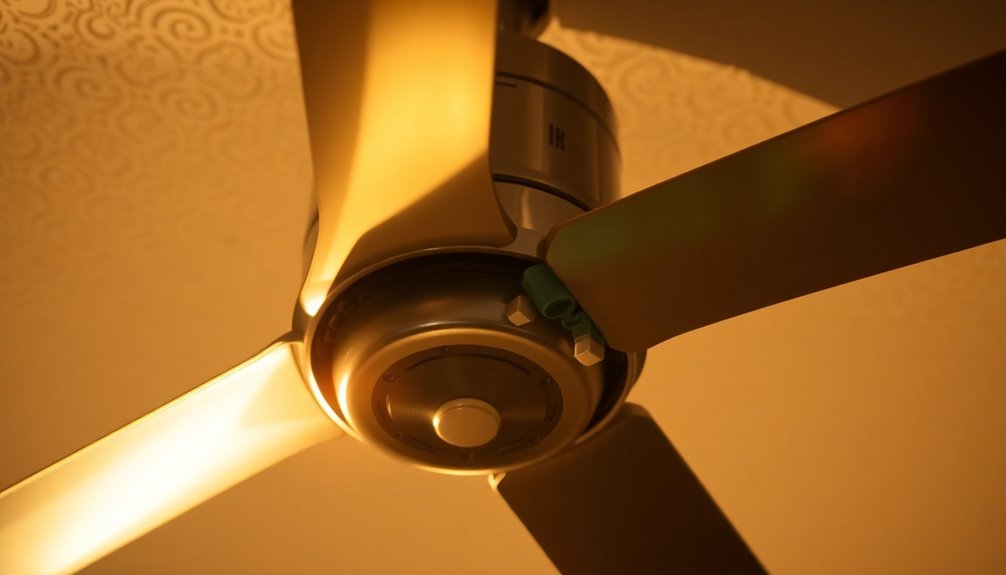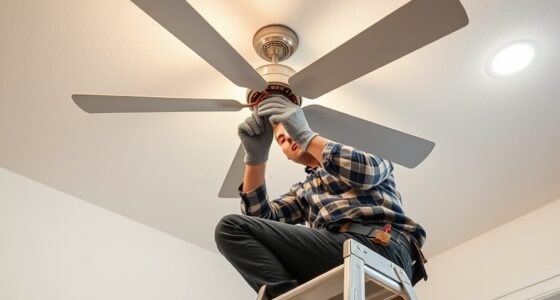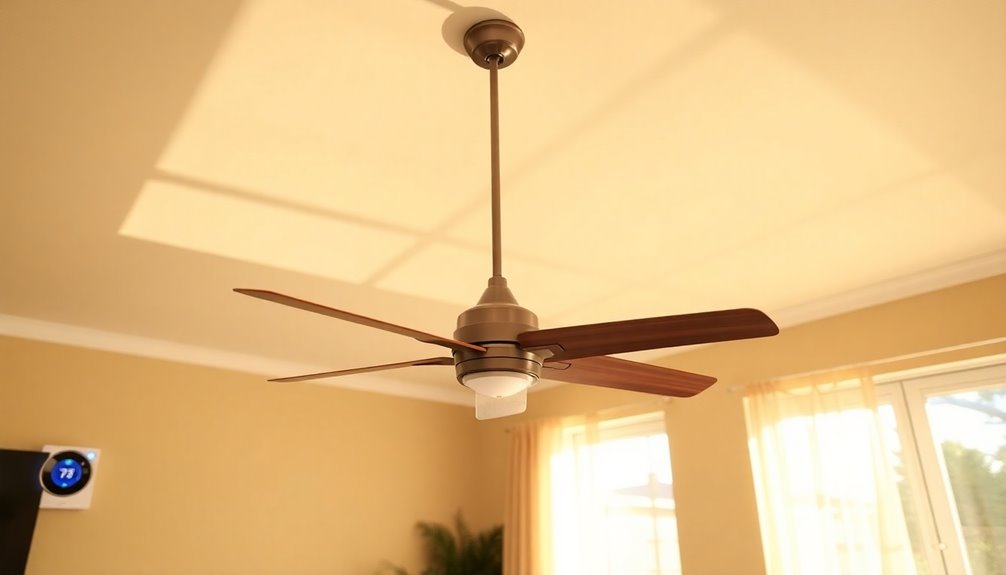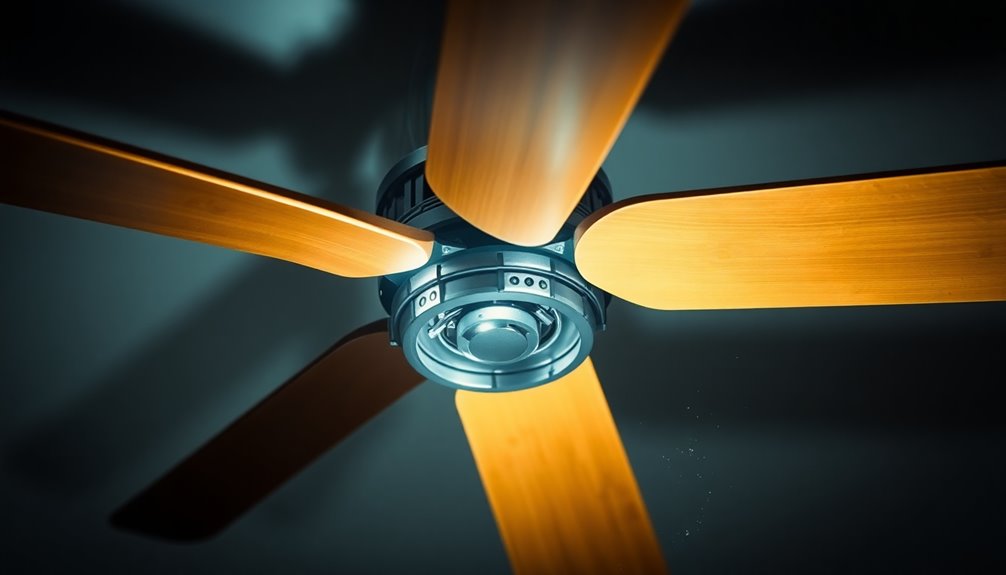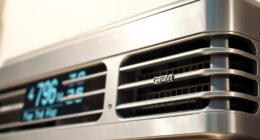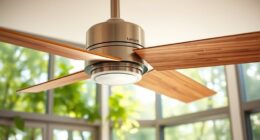A ceiling fan uses surprisingly little electricity, typically consuming between 50 to 80 watts per hour. In contrast, air conditioners can use over 3,500 watts, making ceiling fans a cost-effective alternative for cooling. Running a fan for a few hours each day might only cost you around $0.05, while air conditioners cost considerably more. You can even save more by adjusting your thermostat a bit higher and using a fan to circulate air. If you're curious about maximizing energy efficiency or the best fan options for your space, there's plenty more to explore on this topic.
Key Takeaways
- Ceiling fans typically use between 50 to 80 watts per hour, significantly less than air conditioners that consume up to 3,500 watts.
- Running a ceiling fan for 6 hours costs around $0.054, making it an economical cooling option.
- Energy Star certified ceiling fans are 60% more efficient than standard models, further reducing electricity consumption.
- Regular maintenance, such as cleaning blades, ensures optimal performance and lower electricity costs.
- Raising the thermostat by 4°F while using a ceiling fan can maintain comfort and lower overall energy bills.
Ceiling Fan Electricity Consumption

When it comes to ceiling fan electricity consumption, understanding how much energy these appliances use can help you make informed decisions about your home's cooling options.
A standard ceiling fan typically consumes between 50 to 80 watts per hour when running without lights, making it a cost-effective choice for daily usage. For example, if you're running your fan at 75 watts for 6 hours, you'd use about 0.45 kWh of electricity.
When equipped with lights, however, a ceiling fan consumes more, ranging from 175 to 200 watts per hour.
Even so, the cost of running a 38-watt ceiling fan for 8 hours is just about $0.05 daily, translating to around $18.77 annually. This shows how much power a ceiling fan draws compared to air conditioners, which can consume up to 3,500 watts in the same period. Additionally, choosing energy-efficient models can further reduce your electricity costs while providing effective airflow.
Comparing Ceiling Fans and Air Conditioners

Comparing ceiling fans and air conditioners reveals a stark contrast in energy consumption and cost-effectiveness. When you evaluate their electricity usage, it's clear why ceiling fans are often the better choice for cooling.
- Electricity Usage: Ceiling fans consume only 50 to 80 watts per hour, while air conditioners can use up to 3,500 watts in the same time frame.
- Cost-Effectiveness: Running a ceiling fan for 6 hours costs around $0.054 compared to $1.20 for an air conditioner, showcasing substantial energy savings. Additionally, modern Energy Star certified fans can help maximize these savings even further. Air purifiers can also contribute to energy efficiency by improving indoor air quality without high electricity consumption.
- Thermostat Setting: By raising your thermostat setting by just 4°F while using a ceiling fan, you can feel just as comfortable without increasing your electric bill. Additionally, using fans in conjunction with heat pump systems can further optimize energy efficiency in your home.
These energy-efficient ceiling fans don't aggressively cool a space but effectively circulate existing air, making them a smart choice for homeowners looking to cut costs.
Tips for Energy Efficiency

To maximize the energy efficiency of your ceiling fan, consider a few key strategies. First, invest in an Energy Star-rated ceiling fan, as these models are 60% more energy efficient than conventional fans, greatly reducing electricity consumption.
Regular maintenance is vital; clean your fan blades to enhance airflow efficiency and guarantee peak performance.
When using your ceiling fan, remember that it cools people, not rooms. Turning off fans when a room is unoccupied can save unnecessary energy. Additionally, you can control your thermostat effectively. By adjusting your thermostat by just 4°F while running your ceiling fan at full speed, you can enjoy additional savings on air conditioning costs.
Selecting the appropriate fan size for your room is also important. Larger fans can consume more power than necessary in small spaces, so choose wisely to maximize airflow efficiency.
Finally, if you're not in the room, don't forget to turn off fans to prevent wasted energy. By following these tips, you can enjoy a cooler environment while keeping your energy costs in check. Moreover, using energy-efficient technology can lead to long-term savings on your overall energy bills.
Factors Affecting Ceiling Fan Efficiency

Several factors greatly affect the efficiency of ceiling fans, impacting both performance and energy consumption. Understanding these elements helps you choose the right fan and enhance its use. Here are three key factors to take into account:
- Fan Size: The wattage and power consumption of a fan depend on its size. Larger rooms require bigger fans to guarantee effective airflow, while smaller spaces can use compact, energy-efficient models. Additionally, using a fan with HEPA filtration can help improve overall air quality in the room.
- Speed Settings: The speed settings greatly influence energy usage. Lower speeds typically consume about 10-20 watts per hour, while full speed can use 60-70 watts. Adjusting speeds according to your needs can save electricity.
- Motor Efficiency and Blade Design: The quality of components like motor efficiency and blade design plays a vital role. Energy Star-rated fans can be up to 60% more efficient than standard options, reducing overall power consumption. Additionally, energy-efficient motors can significantly enhance a fan's performance while minimizing energy use.
Keeping your fan clean and well-maintained guarantees peak performance, allowing you to enjoy the benefits of effective cooling with lower electricity costs.
Benefits of Ceiling Fans

Ceiling fans offer numerous advantages that make them a smart choice for any home. One of the biggest benefits is their low electricity usage. While air conditioners can consume up to 3,500 watts, ceiling fans typically use only 50 to 80 watts per hour. This makes them a cost-effective cooling option, costing you around $0.05 for eight hours of use.
By choosing Energy Star-rated ceiling fans, you can enjoy energy savings since these models are 60% more efficient than conventional ones, further contributing to lower energy bills.
Ceiling fans also enhance indoor air quality by promoting airflow throughout your space. This airflow helps reduce humidity and boosts overall comfort, making your living environment more enjoyable.
When you use ceiling fans in conjunction with air conditioning, you can even raise thermostat settings by 4°F without sacrificing comfort. This simple adjustment not only leads to additional energy savings but also lessens the strain on your air conditioning system.
Seasonal Fan Direction Adjustments

Adjusting your ceiling fan's direction seasonally can greatly enhance your home's comfort and energy efficiency.
By making simple seasonal adjustments, you can enjoy a cooling breeze in the summer and circulate warm air in the winter, leading to significant energy savings.
Here's how to adjust your ceiling fan direction effectively:
- Summer (Counterclockwise): Set your fan to rotate counterclockwise. This creates a cooling breeze, allowing you to raise the thermostat by up to 4°F without sacrificing comfort.
- Winter (Clockwise): Reverse the fan's direction to clockwise. This helps circulate warm air that rises to the ceiling, improving heating efficiency and reducing your reliance on HVAC systems.
- Use a Remote or Switch: Many ceiling fans come equipped with a directional switch or remote control, making it easy to switch fan direction between seasons.
Cost Comparison With Other Appliances

How does the energy consumption of a ceiling fan stack up against other common appliances? When you compare ceiling fans to air conditioners, the difference is striking. Ceiling fans consume only 50 to 80 watts per hour, while an air conditioner can use up to 3,500 watts in the same timeframe.
Running a 75-watt ceiling fan for 8 hours costs about $0.096, whereas the air conditioner could hit around $1.20 for that duration. Additionally, using a ceiling fan can enhance the performance of an air purifier by improving airflow in the room.
If you're looking to lower energy costs, consider that energy-efficient ceiling fans can slash annual operating costs to about $18, compared to an air conditioner's hefty $81.50.
Even smaller fans, like table fans, use around 28.5 watts and cost about $1.09 monthly, which is still less than most ceiling fans. Higher wattage fans, such as box fans, might cost around $30 annually.
In terms of the average cost of electricity, running a ceiling fan is a budget-friendly option. Smart toilets can also contribute to lower household energy and water costs through their efficient designs. By understanding the energy usage and cost of your electricity per kilowatt-hour (kWh), you can make informed choices for your home.
Frequently Asked Questions
How Much Does It Cost to Run a Ceiling Fan 24 Hours a Day?
Running a ceiling fan for 24 hours a day typically costs you about $0.30, assuming it consumes around 75 watts.
If you do this daily, your annual expense would be roughly $109.50.
This option's quite cost-effective compared to air conditioning, which could set you back over $1.20 for just 6 hours.
If you choose an energy-efficient model, you could save even more, with costs dropping to around $0.16 daily.
Do Ceiling Fans Raise the Electric Bill?
Oh sure, you're probably imagining your ceiling fan demanding a raise like a diva at a concert, right?
But in reality, ceiling fans don't raise your electric bill much at all. They use only around 50 to 80 watts per hour, which is a steal compared to air conditioners.
If you're sensible and turn it off when you leave the room, you'll barely notice a dent in your monthly expenses.
Do Ceiling Fans Waste a Lot of Electricity?
You might wonder if ceiling fans waste a lot of electricity. The good news is they're quite efficient!
Typically, they consume only 50 to 80 watts per hour, especially when compared to air conditioners. If you run one for around eight hours, your cost is just about five cents.
Are Ceiling Fans Expensive to Run?
Did you know that running a standard 75-watt ceiling fan for 6 hours costs you only about $0.054?
When you compare that to an air conditioner, which can run about $1.20 for the same time, it's clear that ceiling fans aren't expensive to run.
In fact, using a ceiling fan can keep you comfortable while saving you money on cooling costs, especially if you opt for energy-efficient models.
Conclusion
To sum up, using a ceiling fan doesn't have to lead to high electricity bills; in fact, it often coincides with significant savings when compared to air conditioning. By adjusting settings seasonally and keeping efficiency in mind, you'll enjoy a comfortable atmosphere without guilt. As you embrace the gentle breeze of your fan, you'll likely find that the benefits extend beyond just cooling—creating a more inviting space while being kind to your wallet and the planet.

